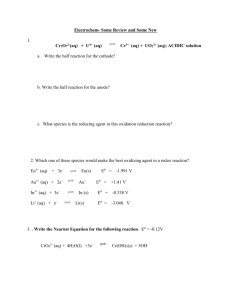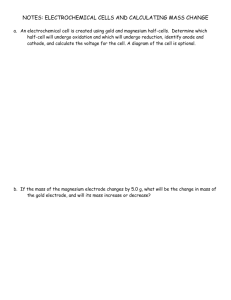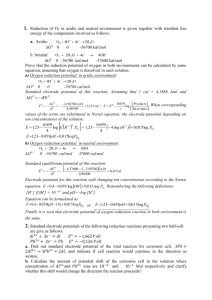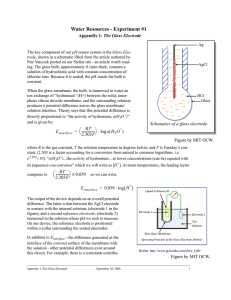english,
advertisement
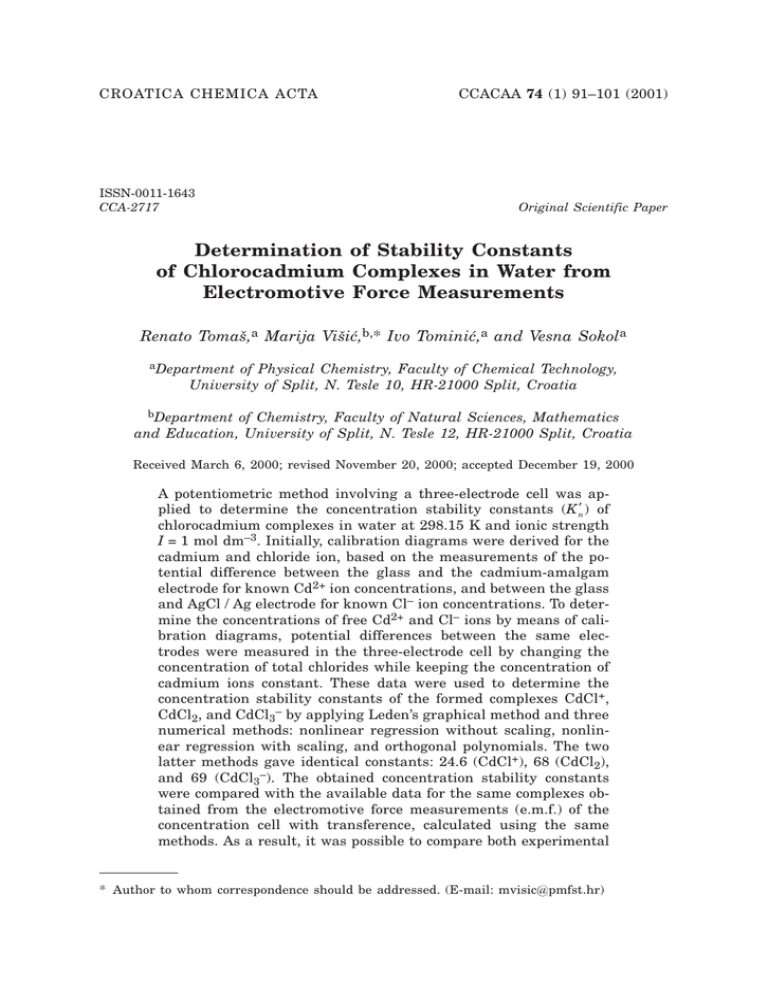
CROATICA CHEMICA ACTA
ISSN-0011-1643
CCA-2717
CCACAA 74 (1) 91¿101 (2001)
Original Scientific Paper
Determination of Stability Constants
of Chlorocadmium Complexes in Water from
Electromotive Force Measurements
Renato Toma{,a Marija Vi{i},b,* Ivo Tomini},a and Vesna Sokola
aDepartment
of Physical Chemistry, Faculty of Chemical Technology,
University of Split, N. Tesle 10, HR-21000 Split, Croatia
bDepartment of Chemistry, Faculty of Natural Sciences, Mathematics
and Education, University of Split, N. Tesle 12, HR-21000 Split, Croatia
Received March 6, 2000; revised November 20, 2000; accepted December 19, 2000
A potentiometric method involving a three-electrode cell was applied to determine the concentration stability constants (K n¢ ) of
chlorocadmium complexes in water at 298.15 K and ionic strength
I = 1 mol dm–3. Initially, calibration diagrams were derived for the
cadmium and chloride ion, based on the measurements of the potential difference between the glass and the cadmium-amalgam
electrode for known Cd2+ ion concentrations, and between the glass
and AgCl / Ag electrode for known Cl– ion concentrations. To determine the concentrations of free Cd2+ and Cl– ions by means of calibration diagrams, potential differences between the same electrodes were measured in the three-electrode cell by changing the
concentration of total chlorides while keeping the concentration of
cadmium ions constant. These data were used to determine the
concentration stability constants of the formed complexes CdCl+,
CdCl2, and CdCl3– by applying Leden’s graphical method and three
numerical methods: nonlinear regression without scaling, nonlinear regression with scaling, and orthogonal polynomials. The two
latter methods gave identical constants: 24.6 (CdCl+), 68 (CdCl2),
and 69 (CdCl3–). The obtained concentration stability constants
were compared with the available data for the same complexes obtained from the electromotive force measurements (e.m.f.) of the
concentration cell with transference, calculated using the same
methods. As a result, it was possible to compare both experimental
* Author to whom correspondence should be addressed. (E-mail: mvisic@pmfst.hr)
92
R. TOMA[ ET AL.
methods applied in determining the concentration stability constants
of chlorocadmium complexes in water medium at 298.15 K and ionic
strength I = 1 mol dm–3.
Key words: direct potentiometry, three-electrode cell, chlorocadmium
complexes, concentration stability constants.
INTRODUCTION
The complexation of CdCl2 in water,1,2,3 and in mixtures of water and an
organic component3,4,5 was investigated by measuring the electromotive
force (e.m.f.) of the concentration cell with transference in solutions of different ionic strengths and at different temperatures. For optimal processing
of the potentiometric data, while calculating the concentration stability constants, K n¢ , besides using the method of successive graphical extrapolations1,2 within Leden’s iterative procedure, several other calculating methods were derived: the method of orthogonal polynomials,3 and the method of
nonlinear regression without scaling6 and with scaling.7,8
Although sophisticated calculating methods were applied, there are two
basic disadvantages of this experimental procedure: the impossibility to
measure the concentration of free chloride ions, [Cl–], and the existence of a
junction potential. Namely, in the iterative procedure, the chlorides were
adjusted simultaneously with the concentration stability constants starting
from the same e.m.f. values that were used for the calculation of the free
Cd2+ ion concentration, [Cd2+]. The junction potential is a component of the
measured e.m.f. of the cell and it is evaluated by the Henderson equation.
To avoid the above mentioned disadvantages, the »direct potentiometry«
method was applied in this work. Namely, there is a standardized method in
literature9 for the determination of chloride ions in various water samples.
The chloride ion concentration is determined directly from the e.m.f. measurements of a cell, consisting of an AgCl / Ag electrode reversible to the Cl–
ion and a glass electrode as reference. However, it is first necessary to perform a potentiometric titration with standard chloride solutions in order to
obtain a calibration diagram E versus log([Cl–] / co), where co = 1 mol dm–3.
In analogy, it is possible to determine the concentration of free Cd2+ ions by
measuring the potential difference between the cadmium-amalgam electrode, Cd(Hg), using a glass electrode as reference. Here again, the calibration diagram E versus log([Cd2+] / co) is derived from the potentiometric titration data.
The complexation reaction of Cd2+ and Cl– is then followed by adding the
chlorides into the three-electrode cell containing a solution of constant con-
93
CHLOROCADMIUM COMPLEXES
centration of total cadmium, ctot(Cd2+), and by measuring the potential difference between the AgCl / Ag and the glass electrode, and between the
Cd(Hg) and the glass electrode. Consequently, there is no junction potential
in these cells. The concentration of free Cd2+ and Cl– ions is determined
from the measured e.m.f. values using the calibration diagram. These data
enable calculation of the concentration stability constants of chlorocadmium
complexes using the same calculating methods as those applied using the
concentration cell with transference.
Finally, the values obtained for the concentration stability constants at
298.15 K and ionic strength I = 1 mol dm–3 were compared with the reported
values3 from the e.m.f. measurements data of the concentration cell with
transference calculated by the orthogonal polynomials method. In this work,
for a more precise comparison, the concentration stability constants were
calculated from the same data using other calculating methods, such as the
method of nonlinear regression with and without scaling, and the classical
graphical Leden’s method.
EXPERIMENTAL
The experimental section involves direct potentiometry and consists of three
steps:
– the calibration diagram for cadmium ions,
– the calibration diagram for chloride ions,
– potentiometric titration in the three-electrode cell to follow the complexation of
the Cd2+ and Cl– ions.
In order to derive the calibration diagram for cadmium ions, it was necessary to
prepare two stock solutions, labelled A1 and B. Stock solution A1 contained 0.01 mol
dm–3 Cd(ClO4)2, 0.01 mol dm–3 HClO4, and (I – 0.04) mol dm–3 NaClO4. Stock solution B was composed of 0.01 mol dm–3 HClO4 and (I – 0.01) mol dm–3 NaClO4. In this
work, all solutions had an ionic strength of I = 1 mol dm–3.
Solution A1 was prepared as described earlier3 from the following reagents: CdO
(p.a. purity grade, »Lafoma«), HClO4 70% (w) (p.a. purity grade, »Merck«), and
NaClO4 × H2O (p.a. purity grade, »Riedel-de-Haën«), while solution B was prepared in
the usual way. All stock solutions were prepared using redistilled water.
The cell for measuring the potential difference between the glass electrode and
the Cd(Hg) electrode was a glass vessel of about 300 cm3 volume with the Pt-wire
fused in at the bottom. One end of the wire was covered with Cd(Hg) in the vessel,
and the other end was inserted into a narrow side tube to establish electrical contact
with the measuring instrument across a Wood alloy and a Cu-wire. The silicone
stopper on the vessel had openings for the glass electrode, a fine tube for the introduction of nitrogen into the solution, and for the burette. Nitrogen was previously
purified and saturated with water vapour.10
Preparation of the Cd(Hg) electrode (w(Cd) = 11%) was described earlier.10
94
R. TOMA[ ET AL.
The reference glass electrode HES 0201 was produced by »Iskra«.
Measurements of the potential difference between the Cd(Hg) and the glass electrode were performed by a pH-meter (MA 5741, Iskra) of 0.1 mV sensitivity. The cell
temperature was maintained constant to 298.15 ± 0.02 K. Starting with the
thermostatting and while reading the e.m.f. values, a slow stream of nitrogen was
being passed through the potentiometric cell. Nitrogen was also used to mix the solution.
E.m.f. measurements for the calibration diagram of Cd2+ ion started by transferring, with a warm dropper, a small amount of warm Cd(Hg) and a specific amount of
solution B into the cell. The glass electrode was then immersed into the solution. After thermostatting for half an hour, the required volume of solution A1 was added using a burette in order to ensure the necessary Cd2+ ion concentration. After 10 minutes, the potential difference between the amalgam electrode and the reference glass
electrode was measured, and the readings were repeated every five minutes until
the value became constant. The procedure continued by adding a new amount of solution A1. A calibration curve for cadmium was then obtained from the recorded potential differences at a defined Cd2+ ion concentration.
To obtain the calibration diagram for chlorides, stock solution B was used as
well as stock solution A2. Stock solution A2 contained 0.70 mol dm–3 NaCl, 0.01 mol
dm–3 HClO4, and (I – 0.71) mol dm–3 NaClO4. Reagent NaCl was p.a. purity grade,
»Kemika«.
The cell for measuring the potential differences between the glass and the
AgCl / Ag electrode was a wider glass tube of about 300 cm3 volume having a silicone
stopper with four openings. The latter were meant for the AgCl / Ag electrode, the
glass electrode, the burette, and a small tube for the passage of extra pure nitrogen.
Nitrogen was treated as before.
The preparation and requirements for the AgCl / Ag electrode were described in
Ref. 11, and the potential difference between the electrodes was measured by a
Feussner potentiometer. The passage of N2 and the maintenance of temperature
while thermostatting were as previously described.
The e.m.f. measurements used for the calibration diagram of the chloride ion
were started by adding a specific amount of solution B into the cell. The AgCl / Ag
electrode and the glass electrode were then immersed into the cell. After
thermostatting for half an hour, the required volumes of solution A2 were added with
a burette, and readings were taken as described for cadmium. The calibration diagram for the chloride ion was drawn from the measured e.m.f. values at known Cl–
concentrations.
The potentiometric titration in the three-electrode cell, the so-called »working«
measurement, required, besides solution A1, the preparation of stock solution C composed of 0.01 mol dm–3 Cd(ClO4)2, 0.01 mol dm–3 HClO4, 0.80 mol dm–3 NaCl, and
(I – 0.84) mol dm–3 NaClO4. Solution C was prepared as described in Ref. 3 from previously described reagents.
An identical and uniform pH in all stock solutions (A1, A2, B, C), which is a prerequisite for the use of a glass electrode as a potential reference, was achieved by
precisely adding the same volume of standardized HClO4 (0.4 mol dm–3), followed by
dilution in a volumetric flask to 1 dm3. The pH of the stock solutions was checked by
95
CHLOROCADMIUM COMPLEXES
means of a combined glass electrode (HEC 0102). The pH-meter was previously calibrated using the standard buffer pH = 2.
The three-electrode cell was identical to the cadmium amalgam cell, however the
silicone stopper had an extra opening for the AgCl / Ag electrode besides the three
openings mentioned earlier. First, the cadmium amalgam and a certain volume of
solution A1 were placed into the cell. The AgCl / Ag electrode and the glass electrode
were then immersed into the solution, and the cell was blown-through with nitrogen
and thermostatted for half-an-hour. Then, precise volumes of solution C, calculated
with respect to the required concentration of total chlorides (ctot(Cl–)), were added
into the cell. The potential difference between the amalgam and the glass electrode
(E1), and between the AgCl / Ag and the glass electrode (E2) was then separately
measured following the same time intervals as earlier. The equilibrium concentration of the Cd2+ and Cl– ions was directly determined from the calibration diagram
using the E1 and E2 values previously obtained.
Since the glass electrode served as the reference electrode in all three steps of
the experimental procedure, the stability of its response was checked against a chosen AgCl / Ag electrode. The potential difference between these two electrodes was
measured in a solution containing 0.01 mol dm–3 HClO4, 0.1 mol dm–3 NaCl, and
0.89 mol dm–3 NaClO4 at 298.15 K before and after the experimental procedure. During the whole experiment (about 10 hours), the glass electrode showed excellent stability.
RESULTS AND DISCUSSION
The Cd2+ and Cl– ions form complexes in aqueous solution according to
the following relations:
Cd2+ + nCl– = CdCln(2–n)+, (n = 1, 2, 3 and 4).
(1)
The expression for the concentration equilibrium constants (concentration stability constant) is as follows:
K n¢ =
[CdCl n (2- n )+ ]/c°
.
{[Cd 2+ ]/c° }{[Cl - ]/c° }n
(2)
The expression in brackets represents the equilibrium concentration of
the involved species.
To obtain the concentration stability constants by the method of nonlinear regression, the equation
x - [Cd 2+ ]
= F{[Cl–]} = K 1¢ [Cl–] + K 2¢ [Cl–]2 + K 3¢ [Cl–]3 + K 4¢ [Cl–]4
[Cd 2+ ]
(3)
was used; scaling was performed by multiplying the same equation by weighing factor [Cd2+] / x, and before applying the method of orthogonal polynomials,
96
R. TOMA[ ET AL.
equation (3) was divided by the concentration of free chloride ions.5 In the
above equation, x denotes the concentration of total cadmium (0.01 mol dm–3).
Values of K n¢ , obtained from e.m.f. data for a concentration cell3 using
the method of orthogonal polynomials (II), are given in Table I. In this work,
new K n¢ values were calculated from the same data, but using other methods, such as the classical graphical Leden’s method (I), as well as the
method of nonlinear regression without scaling (III) and with scaling (IV).5
These are also shown in Table I. Table I also presents the corresponding
standard deviations derived in a manner described in literature.12a Parameters K 1¢ and K 2¢ of the original polynomial in method II were derived as linear combinations of parameters of Forsythe orthogonal polynomials,12a so
that their standard deviations can be calculated according to Ref. 12b. The
correlation coefficient, R2, measures the goodness of fit of the corresponding
polynomial to the experimental data. Values are calculated according to an
example in the literature13 and presented in the same Table.
TABLE I
Concentration stability constants of chlorocadmium complexes in water, calculated
by different methods from the e.m.f. of the concentration cell with transference3
at an ionic strength of I = 1 mol dm–3 and 298.15 K, including the values of the
respective correlation coefficient R2
Method
I
Ref. 14
II
III
IV
23.0 ± 0.8
25.7 ± 1.4
23.3 ± 0.8
22.4 ± 1.0
K1¢
K 2¢
21.7
51
51 ± 10
26 ± 11
51 ± 10
50 ± 12
K 3¢
60
50 ± 24
102 ± 21
45 ± 25
32 ± 15
0.9925
0.9998
0.9936
R2
The values in Table I are fairly consistent. Even Leden’s laborious method,
which accumulates errors into higher constants, agrees well with the numerical methods. Again, the concordance with the literature data (sixth column) is good. The only discrepant values are those for K 2¢ and K 3¢ of nonlinear regression (III), as already established in t-butanol + water mixtures.5
In order to determine the concentration stability constants by means of
»direct potentiometry«, it was first necessary to perform measurements for
the calibration diagrams. Namely, the e.m.f. values of the cell Cd(Hg) and
glass electrode (E1) for different known concentrations of free cadmium were
measured as presented in Table II. In this case, the free Cd2+ ion concentra-
97
CHLOROCADMIUM COMPLEXES
TABLE II
Potential differences between the Cd(Hg) and glass electrode (E1) for known
concentrations of Cd2+ ion, and between the AgCl / Ag and glass electrode (E2) for
known concentrations of Cl– ion in water at an ionic strength of I = 1.0 mol dm–3
and 298.15 K
[Cd 2+ ]
[Cl- ]
E1
V
mol dm-3
E2
V
0.0005
0.9694
0.02
0.1804
0.0010
0.9600
0.06
0.2087
0.0015
0.9560
0.10
0.2213
0.0020
0.9523
0.14
0.2299
0.0025
0.9499
0.18
0.2362
0.0030
0.9475
0.22
0.2411
0.0035
0.9455
0.26
0.2453
0.0040
0.9440
0.30
0.2488
0.0045
0.9425
0.34
0.2519
0.0050
0.9412
0.38
0.2546
mol dm
-3
tion equals the concentration of total cadmium, because the Cd2+ ion does
not form complexes with the ClO4– ion. The same table shows the e.m.f. values of the cell AgCl / Ag and glass electrode (E2) for different known concentrations of free chloride. All of these values were obtained in water medium
for an ionic strength of I = 1 mol dm–3 at 298.15 K.
Plots of E1 against log([Cd2+] / c°) and of E2 against log([Cl–] / c°) are
given in Figures 1 and 2, and they denote the calibration dependence for
cadmium, and for chloride ions, respectively. The straight line equations, obtained by the least-squares method, and the corresponding correlation coefficients are
E1 / V = 0.8763 – 0.0282 log([Cd2+] / c°),
(R2
= 0.9987)
E2 / V = 0.2792 + 0.0579 log([Cl–] / c°).
(R2
(4)
(5)
= 0.9999)
The straight line slopes for cadmium (–28.2 mV) and for chlorides (57.9
mV) are in quite a good agreement with the theoretically predicted values of
–29.58 mV and 59.15 mV, respectively.
98
R. TOMA[ ET AL.
Figure 1. Variation of the potential difference between the Cd(Hg) and glass electrode
(E1 / V) versus logarithm of Cd2+ ion concentration (Cd(ClO4)2) in water media at an
ionic strength of I = 1.0 mol dm–3 and 298.15 K (according to data from Table II).
Figure 2. Variation of the potential difference between the AgCl / Ag and glass electrode (E2 / V) versus logarithm of Cl– ion concentration (NaCl) in water media at an
ionic strength of I = 1.0 mol dm–3 and 298.15 K (according to data from Table II).
99
CHLOROCADMIUM COMPLEXES
TABLE III
Potential differences between the Cd(Hg) and glass electrode (E1), AgCl / Ag
and glass electrode (E2), and equilibrium concentrations of Cd2+ and Cl– ions for
different concentrations of total chloride (ctot(Cl–)) in water at an ionic strength
of I = 1.0 mol dm–3 and 298.15 K
[Cd 2+ ]
[Cl- ]
ctot (Cl- )
mol dm-3
E1
V
E2
V
0.075
0.9460
0.2112
0.00337
0.0670
0.100
0.9491
0.2187
0.00262
0.0902
0.150
0.9544
0.2294
0.00170
0.1380
0.200
0.9587
0.2370
0.00120
0.1866
0.252
0.9627
0.2430
0.00086
0.2371
0.300
0.9658
0.2475
0.00067
0.2838
0.350
0.9688
0.2515
0.00052
0.3327
mol dm
-3
mol dm-3
The results of e.m.f. measurements in the three-electrode cell for different concentrations of NaCl (ctot(Cl–)) are shown in Table III together with
the corresponding values of the equilibrium concentrations of Cd2+ and Cl–
ions obtained from the calibration diagrams.
The equilibrium concentration of Cd2+ and Cl– ions served to calculate
the concentration stability constants, K n¢ , using the four methods mentioned
earlier. The calculation then proceeded in one step, since the chlorides were
obtained directly from the experiments. Standard deviations of the parameters and the correlation coefficient were calculated in the same way as for
the concentration cell (Table I). The results are given in Table IV.
TABLE IV
Concentration stability constants, K n¢ , of the chlorocadmium complexes in water
calculated by different methods from »direct potentiometry« data at an ionic
strength of I = 1.0 mol dm–3 and 298.15 K, including the values of the respective
correlation coefficient R2
Method
I
K1¢
25.0
K 2¢
63
K 3¢
75
R2
II
III
IV
24.6 ± 0.5
24.7 ± 1.1
24.6 ± 0.5
68 ± 6
66 ± 10
68 ± 6
69 ± 15
73 ± 21
69 ± 16
0.9993
0.9999
0.9976
100
R. TOMA[ ET AL.
It can be seen from Table IV that three complex-species were also identified by direct potentiometry, i.e. CdCl+, CdCl2, and CdCl3–. The concentration stability constants obtained by different calculating methods are in
very good agreement; moreover, methods II and IV yield identical values,
differing only slightly from method III. Considering of their standard deviations, preference could undoubtedly be given to the methods of orthogonal
polynomials (II) and nonlinear regression with scaling (IV).
A comparison of the results obtained by both experimental techniques
(Tables I and IV) indicates that the direct potentiometry data are better correlated with the corresponding functions and the stability constants are obtained with greater precision. There is a satisfactory agreement of all K 1¢
values. The K 2¢ and K 3¢ values obtained by method II and IV display a slight
difference and those obtained by method III are in total disagreement.
In conclusion, it seems that direct potentiometry is a more reliable experimental technique in the investigated system. Further research will
therefore be of interest, particularly in mixed water-organic solvents.
Acknowledgement. – This work was supported by the Ministry of Science and
Technology of the Republic of Croatia (Project No. 011008).
REFERENCES
1.
2.
3.
4.
5.
6.
7.
8.
9.
10.
11.
12.
13.
14.
I. Leden, Z. Phys. Chem. A188 (1941) 160–181.
C. E. Vanderzee and H. J. Dawson, J. Am. Chem. Soc. 75 (1953) 5659–5663.
M. Vi{i}, A. Jadri}, and I. Mekjavi}, Croat. Chem. Acta 66 (1993) 489–498.
M. Vi{i} and I. Mekjavi}, Croat. Chem. Acta 69 (1996) 17–26.
M. Vi{i}, R. Toma{, and I. Mekjavi}, Croat. Chem. Acta 72 (1999) 55–70.
F. R. Hartley, C. Burgess, and R. M. Alcock, Solution Equilibria, Wiley, New York,
1980, pp. 87–106.
E. A. Neves, N. C. Milcken, L. G. R. Gutz, and R. G. Tavares, An. II Simp. Brasil.
Eletroq. Electroanal. Sao Paulo, 1980, pp. 152–159.
E. A. Neves and J. F. Andrade, Polyhedron 5 (1986) 717–721.
R. A. Stairs and R. C. Makhija, American Laboratory News Edition, August 1989.
M. Vi{i} and I. Mekjavi}, J. Chem. Thermodynamics 21 (1989) 139–145.
D. J. G. Ives and G. J. Janz, Reference Electrodes, Academic Press, New York,
1961, p. 203.
B. Carnahan, H. A. Luther, J. O. Wilkes, Applied Numerical Methods, John Wiley
and Sons, New York, 1969, a) p. 574, b) p. 534.
D. M. Himmelblau, Process Analysis by Statistical Methods, John Wiley and Sons,
New York, 1970, p. 41.
A. E. Martell, R. M. Smith, Critical Stability Constants, Vol. 4, Plenum Press,
New York, 1981, p. 108.
101
CHLOROCADMIUM COMPLEXES
SA@ETAK
Odre|ivanje konstanti stabilnosti klorokadmijevih kompleksa u vodi
iz mjerenja elektromotorne sile
Renato Toma{, Marija Vi{i}, Ivo Tomini} i Vesna Sokol
Potenciometrijskom metodom uz upotrebu trielektrodnog ~lanka odre|ene su
koncentracijske konstante stabilnosti (K n¢ ) klorokadmijevih kompleksa u vodenoj
otopini ionske jakosti I = 1 mol dm–3 pri 298,15 K. Prvo su izra|eni ba`darni dijagrami za kadmijeve i kloridne ione i to na osnovi mjerenja potencijalne razlike izme|u
staklene i kadmij-amalgamske elektrode za poznate koncentracije Cd2+-iona, odnosno
izme|u staklene i AgCl / Ag elektrode za poznate koncentracije Cl–-iona. Da bi se s
pomo}u ba`darnih dijagrama odredile koncentracije slobodnih kadmijevih i kloridnih
iona, mjerene su potencijalne razlike izme|u istih elektroda u trielektrodnom ~lanku, promjenom koncentracije ukupnih klorida uz konstantnu koncentraciju kadmija.
Iz tih su podataka izra~unane koncentracijske konstante stabilnosti nastalih kompleksa CdCl+, CdCl2 i CdCl3–, i to upotrebom Ledenove grafi~ke metode te triju
numeri~kih metoda: nelinearne regresije bez skaliranja, nelinearne regresije sa skaliranjem i ortogonalnih polinoma. Dvije posljednje metode dale su identi~ne konstante,
naime: 24,6 (CdCl+), 68 (CdCl2) i 69 (CdCl3–). Dobivene koncentracijske konstante
stabilnosti uspore|ene su s objavljenim podacima za iste komplekse dobivenim iz mjerenja e.m.s. koncentracijskog ~lanka s prijenosom, a izra~unane istim metodama. To je,
nadalje, omogu}ilo usporedbu samih eksperimentalnih metoda odre|ivanja koncentracijskih konstanti stabilnosti klorokadmijevih kompleksa u vodenom mediju pri 298,15 K
i ionskoj jakosti I = 1 mol dm–3.
